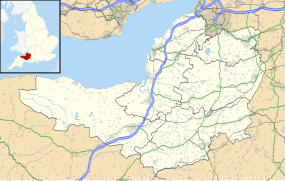Stoney Littleton Long Barrow
 |
|
| Alternate name | Bath Tumulus and Wellow Tumulus |
|---|---|
| Location | near Wellow |
| Region | Somerset, England |
| Coordinates | 51°18′48″N 2°22′54″W / 51.31335°N 2.38168°WCoordinates: 51°18′48″N 2°22′54″W / 51.31335°N 2.38168°W |
| Type | Chambered long barrow |
| History | |
| Periods | Neolithic |
| Site notes | |
| Condition | intact |
| Public access | yes |
The Stoney Littleton Long Barrow (also known as the Bath Tumulus and the Wellow Tumulus) is a Neolithic chambered tomb with multiple burial chambers, located near the village of Wellow in the English county of Somerset. It is an example of the Severn-Cotswold tomb and was scheduled as an ancient monument in 1882. It was one of the initial monuments included when the Ancient Monuments Protection Act 1882 became law.
The chambered long barrow was built around 3500 BC. Excavations in the early 19th century uncovered bones from several individuals. The stone structure is about 30 metres (98 ft) in length and contains a 12.8 metres (42 ft) long gallery with three pairs of side chambers and an end chamber.
The barrow is approximately 1.5 kilometres (0.93 mi) south west of the village of Wellow. It is on a limestone ridge overlooking Wellow Brook approximately 200 metres (660 ft) to the north and west of the barrow. It is surrounded by a rectangular grass area accessed via a stile and footpath from a car park at Stoney Littleton Farm.
Chambered long barrows were constructed during the Neolithic between 4000 and 2500 BC for the ritual inhumation of the dead. Stoney Littleton Long Barrow was probably constructed around 3500 BC.
The tomb was first opened around 1760 by a local farmer to obtain stone for road building. The site was excavated by John Skinner and Richard Hoare in 1816-17, who gained the entry through the hole which was made previously. The excavation revealed the bones (some burned) of several individuals. The mound was restored in 1858 by Thomas Joliffe. Some of the artefacts from the excavations are in the Bristol City Museum and Art Gallery.
...
Wikipedia

